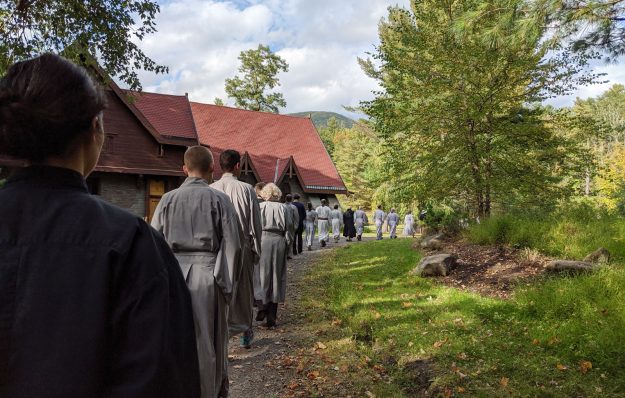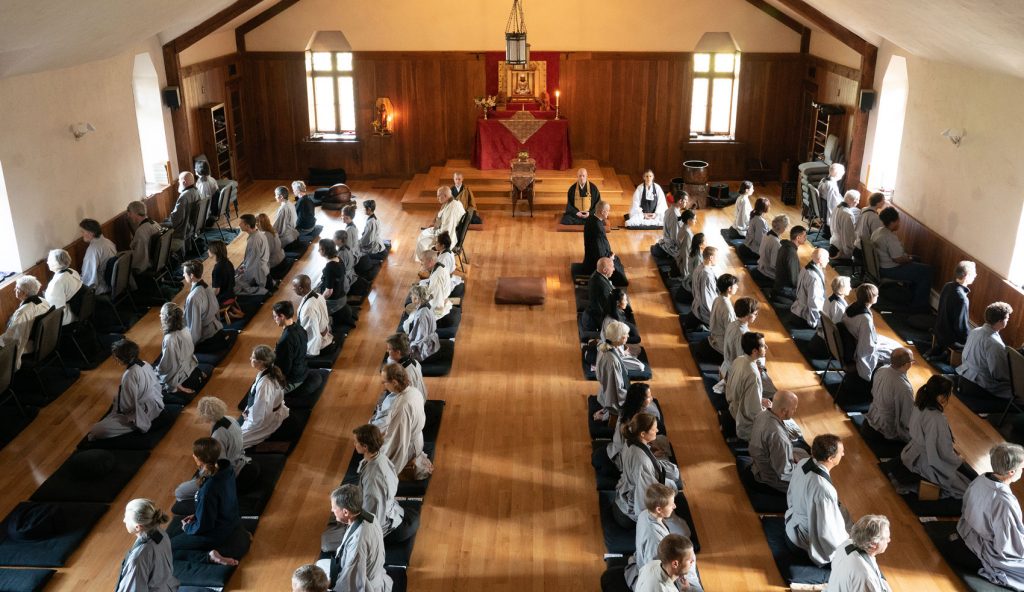If there is anything that living through a global pandemic has taught us, it’s the importance of community and interdependence. But what has this time shown us about our blind spots when it comes to matters of inclusivity? How can we become more conscious around barriers to access when it comes to seeing who is in the room and who isn’t?
Dharma centers like East Bay Meditation Center in Oakland, California were founded on radical inclusivity, and, alongside countless others, continue to actively advance this principle. Increasingly, culturally specific sanghas, independent and within established dharma centers, provide safe spaces for those who need them. But the pause of in-person gatherings over the past year and a half provided a natural time for further reflection and mobilization.
Tricycle spoke to three dharma centers about the ways the pandemic has affected their understanding of inclusivity within their own sanghas and the concrete steps they are taking to cultivate a more equitable society.
***
Durango Dharma Center
When the Durango Dharma Center in southwestern Colorado went into quarantine last year, among the early questions raised by leadership were, “What does dharma look like during a pandemic?” and “How do we keep the community strong while not leaving anyone behind despite the range of needs among practitioners?”
With in-person gatherings on hold, there was concern for members who lived alone or had a limited support system. In response, the center created the Compassionate Listeners program, connecting sangha members with a peer listener who could walk them through a challenging time. Not unlike the sangha’s other program offerings, Compassionate Listeners use the Kalyana Mitta model, a Pali term meaning “spiritual friend,” as a means of nurturing a sense of belonging and connectedness.
Erin Treat, a guiding teacher and 25-year member of Durango Dharma, noted that it’s not therapy—nor is it meant to act as a substitution for it. It is meant to connect people.
“Anybody who is in need, could send us an email and we connect them with a person who might be the best fit for them,” she said. The program draws from a handful of “compassionate listeners,” all of whom are senior dharma students at the center. “It’s kind of a no-brainer to have a program like this,” she said. “It’s really, really isolating for some of our elders, in particular, and we want to be sure they weren’t just left behind.”
The center also instituted a Sangha Care program, which provides assistance to sangha members who need help with grocery shopping, dog walking, and errands—through an all volunteer network. As restrictions ease in the coming months the sangha hopes to offer meal preparation, light household chores, and transportation to and from the Dharma Center for programs and retreats.
Both the Sangha Care and the Compassionate Listeners program will continue as things open back up. But being able to respond to those needs so that everyone feels seen and heard is not easy. Treat said it has been the willingness of at least 40 active volunteers who step up when needed that makes it all possible. “People just keep saying, ‘How can I help? What do people need?’”
Zen Mountain Monastery
In July, Zen Mountain Monastery in Mount Tremper, New York unveiled a new Jizo house as part of a multi-year initiative to make the monastery grounds and buildings more accessible and inclusive. The modern, 4,800 square foot building expands accommodations for residents and retreat participants with a firm nod toward those with accessibility issues.
The original Jizo house was a former parsonage built in 1929 when the property was a Christian retreat center. Zen Mountain bought the house and land in 1980 and since then the structure has provided housing, office space, and a place for the Monastery store. As the community noted on its website, “the building is at the end of its life” and was demolished to make way for a newer and much larger incarnation.
All of this speaks to the sangha’s ever growing, and aging congregation. “In our main building, when people come for retreat, most stay in a dorm room with a bunk bed,” said operations manager Bear Gokan Bonebakker. “Older members of our sangha are not really able to do that.” The new building has eight double rooms with no bunk beds. One room is fully ADA compliant and can also be used as a room for monastics who need end-of-life care.

In the monastery’s main building a lift was installed to allow greater access between the dining hall on the ground floor and the zendo, one flight up. The sangha reconfigured a guest room on the second floor that is also ADA compliant. Being able to move freely between guest room, dining hall, and the zendo means “someone using a wheelchair could fully participate in sesshin now,” said Bonebakker.
Railings in the main building have also been installed, along with ongoing improvements in lighting along the sidewalk for greater visibility between buildings. For those with hearing issues, the monastery relies on headsets when amplification within the zendo is used, but that too will need upgrading soon.
Fundraising for the project took less than a year and brought in one million dollars. Work on the new Jizo house began in June of 2020 and was finished one year later. The dedication ceremony took place on July 25th, in time for the monastery’s 40th anniversary.
While the sangha remains closed due to the pandemic, using this time to make Zen Mountain Monastery a more inclusive and hospitable retreat center is worthwhile. Bonebakker said, “It’s about making this place accessible so that members can practice here for as long as they possibly can.”
Rochester Zen Center
Rochester Zen Center (RZC) in upstate New York is one of the oldest and largest Zen Buddhist centers in the country. The move to online during the pandemic was a big reveal in just how large the wider sangha had become with nearly 60 people logging on from across the country for the group’s daily morning zazen.
“We noticed right away that we had this new life, new energy to the sangha,” said Donna Kowal, RZC’s programs office manager. But what the pandemic brought to light was how the core focus on Zen training and Zen practice was superseding what it means to be in community with other practitioners.
“The folks that would travel here once or more a year for sesshin now engage with us on a daily basis through the online offerings.” Kowal said getting to know people she previously only saw and spoke to sporadically during in-person retreats has been gratifying.
“I used to only see them during sesshin,” she said, laughing, “Maybe I see their feet in the zendo.” But with the extended time together online, that sense of community is much richer now. “We see that and the path forward is not to make sacrifices to the training, and the practice, but how to integrate them,” she said.
Last summer was a turning point for the sangha as Black Lives Matter protests erupted across the country in response to the death of George Floyd. Sangha programs coordinator Dene Redding said, “The whole world was starting to put out these statements about George Floyd. We had to really think about how we live up to the statements that we would want to write.”
In coming up with a mission statement and educational programming around systemic racism, the center was able to tap the expertise of one of their out-of-town members who helps organizations deal with equity and justice. With resounding support from the sangha’s trustees, a group called “Uprooting Racism” was formed with the sole purpose of “acknowledging and addressing issues of racism and racial inequity and to join Zen Centers across the United States in denouncing white supremacy.”
One of their inaugural programs looked at racism within the Zen Buddhist community and anti-Asian violence. Interest in these kinds of discussions remains strong, with the acknowledgement that cultural shifts take time. Kowal said, “We can’t tell what this programming may or may not yield in terms of changes in our membership. We just know that we need to do this work.”
The center also has continuing discussions on how to be more in community with people who live and work in Rochester. “It’s not like in the Zen tradition that we proselytize and can draw people in,” said Kowal. “What can we be doing that we’re currently not doing that would make people more aware of the center as a resource?” And while in-person events like the annual celebration of Buddha’s birthday draws an enthusiastic crowd, meeting the needs of the local community while not leaving behind those who live elsewhere remains a delicate balance.
Despite all the challenges, watching the culture shift as Buddhist communities wrestle with what it means to live in equanimity with other living beings has been exciting for people like Redding.
“The dharma is not complete in any one of us,” she said. “It takes all of us.”
Thank you for subscribing to Tricycle! As a nonprofit, we depend on readers like you to keep Buddhist teachings and practices widely available.
